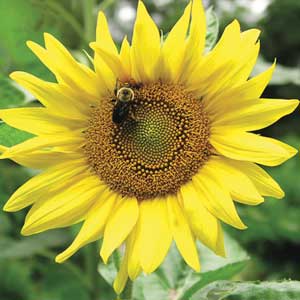
By Linda Wiggen Kraft,
Healthy Planet Green & Growing Editor
This summer be sure to include sunflowers in your garden. Sunflowers (helianthus) are the flowers of sunshine and happiness. They brighten any garden, are easy to grow and are essential for the well-being of insects and birds. Their importance in our garden isn’t just for beauty, their importance is that they are keystone native plants. Like the center stone in a stone arch that locks and holds the whole thing together, a keystone native plant holds an ecosystem together. Keystone native plants are the most important native plants because they support the life of the most numbers of butterflies, moths and bees.
Sunflowers are host plants for over 66 species of butterflies and moths who lay eggs on the plants. Caterpillars emerge from the eggs and eat the leaves. These caterpillars have evolved to only be able to survive on sunflower plants. Birds feed caterpillars to their babies, the main source of food for baby birds. Sunflowers also provide nectar for 50 species of bees that will only survive with this plant’s nectar.
Sunflowers are both annuals and perennials. There are many different sunflowers beyond the annual sunflower with one big flower and lots of seeds. Bird seed sunflower seeds, if scattered in the garden, will often germinate and grow with many small flowers. This is one of the easiest ways to grow sunflowers, simply scatter seeds in the garden. There are many different seeds for annual sunflowers that grow different heights, colors and sizes. Most seed catalogs carry many possibilities. The annual sunflower’s botanical name is Helianthus annuus.
There are perennial sunflowers, one of which has an edible tuber root. Jerusalem Artichoke is its main common name. It is not an artichoke. Its botanical name is Helianthus tuberosus.. The above ground part of this sunflower grows up to six feet tall with multiple yellow two-inch flowers in later summer. Other perennial sunflowers native to Missouri are: Narrow-leaved (swamp) sunflower (Helianthus. angustifolius), Thin-leaved (pale) sunflower (Healianthus. decapetalus), Woodland sunflower (Helianthus divaricatus), Sawtooth sunflower (Helianthus. grosseserratusz), Maximilian sunflower (Helianthus maximilianii), Small woodland sunflower (Helianthus microcephalus), Ashy sunflower (Helianthus mollis), Naked-stemmed sunflower (Helianthus occidentalis), Stiff (prairie) sunflower (Helianthus pauciflorus). Prairie (Kansas, plains) sunflower (Helianthus petiolaris), Willow-leaved sunflower (Helianthus salicifolius). Rosinweed sunflower (Helianthus silphioides) and Pale-leaved sunflower (Helianthus strumosus).
Plant sunflowers in your garden this year. You will add beauty and help ensure the life of many insects that we need for all of our lives. Bring beauty, butterflies, moths and bees into your garden with these amazing native keystone plants.
Linda Wiggen Kraft is a landscape designer of holistic and organic gardens. She is also an artist and creativity workshop leader. Her next art workshop will be July 22, 2023. Find out more, subscribe to her blog and Instagram at www.CreativityForTheSoul.com, Call her at 314 504-4266.


